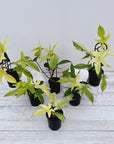


Philodendron pedatum 'Florida Ghost'
Philodendron Pedatum 'Florida Ghost' is a unique and highly sought-after plant, known for its distinct, lobed leaves that change colour as they mature. New leaves emerge in a striking pale white or minty green, resembling the appearance of a "ghost," which is where its name comes from. Over time, the leaves gradually transition to a deeper green. The plant has a climbing habit, making it ideal for a moss pole or trellis. Its rare, ornamental appearance, along with its ability to purify the air, makes it a prized plant among aroid collectors.
Philodendron Pedatum 'Florida Ghost' Care Plan:
Light:
- The 'Florida Ghost' thrives in bright, indirect light. This helps to encourage the beautiful, pale new growth that the plant is known for.
- Avoid direct sunlight, which can cause the delicate leaves to scorch. If the light is too low, the plant may lose its signature pale leaves and produce more green ones.
Watering:
- Water when the top 2-5 cm (1-2 inches) of soil is dry. Water thoroughly, allowing water to drain out of the bottom of the pot.
- Be mindful not to let the plant sit in water, as it is sensitive to root rot.
- Reduce watering in winter when the plant's growth naturally slows.
Humidity:
- Philodendron 'Florida Ghost' enjoys high humidity levels of around 60-80%. It thrives in a more humid environment, which can be provided by misting, placing the plant on a pebble tray, or using a humidifier.
- In lower humidity, the leaves may not reach their full potential and could develop brown tips.
Temperature:
- Ideal temperatures for this plant are between 18°C and 27°C. Keep it away from cold drafts or temperatures below 15°C, as it is sensitive to cold.
Soil:
- Use a well-draining aroid mix that holds some moisture but doesn’t become waterlogged. A mix of potting soil, perlite, orchid bark, and peat moss works well for this plant.
Fertilising:
- Feed with a balanced, water-soluble fertiliser every 4-6 weeks during spring and summer when the plant is actively growing.
- Reduce fertilising in the cooler months when growth slows.



